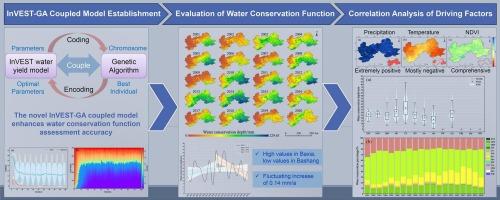A new InVEST–genetic algorithm coupled water yield model: Application to water conservation function assessment in the Zhangjiakou-Chengde area
IF 7
2区 环境科学与生态学
Q1 ENVIRONMENTAL SCIENCES
引用次数: 0
Abstract
Water conservation function (WCF) of the ecosystem is critical for maintaining ecological balance and managing water resource. To address the limitations of empirical parameters in the Integrated Valuation of Ecosystem Services and Trade-offs (InVEST) water yield model, this study proposes an InVEST-Genetic Algorithm (InVEST-GA) coupled model that incorporates genetic algorithms for global parameter optimization. This coupled model, combined with high-resolution TerraClimate precipitation data, was used to evaluate the WCF in Zhang-Cheng (Zhangjiakou and Chengde) area. The result indicated that: (1) WCF shows higher values in Baxia (lower plains and hills) and lower in Bashang (high plateau) regions; (2) From 2001 to 2020, water conservation depth (WCD) increased at an average of 0.14 mm/year, with an initial rise followed by a decline; (3) Among ecosystems, croplands exhibited the highest WCD, while grasslands contributed most to water conservation volume; (4) Precipitation positively influenced WCF whereas temperature had a negative temporal effect. Vegetation impacts were complex and varied across ecosystems and years; (5) Sensitivity analysis indicated exponential decline in parameter influence on WCD, with grasslands being the most sensitive. The InVEST-GA framework significantly improves accuracy and offers a robust foundation for eco-hydrological studies and ecosystem service evaluation in the Zhang-Cheng area.

一种新的invest -遗传算法耦合产水量模型在张家口-承德地区保水功能评价中的应用
生态系统的保水功能对维持生态平衡和水资源管理具有重要意义。为了解决生态系统服务与权衡综合评估(InVEST)模型中经验参数的局限性,本研究提出了一个采用遗传算法进行全局参数优化的InVEST-遗传算法(InVEST- ga)耦合模型。利用该耦合模型,结合高分辨率terrclimate降水资料,对张城(张家口-承德)地区WCF进行了评价。结果表明:(1)低平原丘陵地区WCF值较高,高高原地区WCF值较低;(2) 2001 ~ 2020年,保水深度(WCD)以平均0.14 mm/年的速度增加,呈现先上升后下降的趋势;(3)各生态系统中,农田保水容量最大,草地保水容量贡献最大;(4)降水对WCF有正向影响,而温度对WCF有负时间影响。不同生态系统和年份对植被的影响复杂多样;(5)敏感性分析表明,各参数对WCD的影响呈指数递减,其中草原对WCD的影响最为敏感。InVEST-GA框架显著提高了精度,为张城地区生态水文研究和生态系统服务评价提供了坚实的基础。
本文章由计算机程序翻译,如有差异,请以英文原文为准。
求助全文
约1分钟内获得全文
求助全文
来源期刊

Ecological Indicators
环境科学-环境科学
CiteScore
11.80
自引率
8.70%
发文量
1163
审稿时长
78 days
期刊介绍:
The ultimate aim of Ecological Indicators is to integrate the monitoring and assessment of ecological and environmental indicators with management practices. The journal provides a forum for the discussion of the applied scientific development and review of traditional indicator approaches as well as for theoretical, modelling and quantitative applications such as index development. Research into the following areas will be published.
• All aspects of ecological and environmental indicators and indices.
• New indicators, and new approaches and methods for indicator development, testing and use.
• Development and modelling of indices, e.g. application of indicator suites across multiple scales and resources.
• Analysis and research of resource, system- and scale-specific indicators.
• Methods for integration of social and other valuation metrics for the production of scientifically rigorous and politically-relevant assessments using indicator-based monitoring and assessment programs.
• How research indicators can be transformed into direct application for management purposes.
• Broader assessment objectives and methods, e.g. biodiversity, biological integrity, and sustainability, through the use of indicators.
• Resource-specific indicators such as landscape, agroecosystems, forests, wetlands, etc.
 求助内容:
求助内容: 应助结果提醒方式:
应助结果提醒方式:


